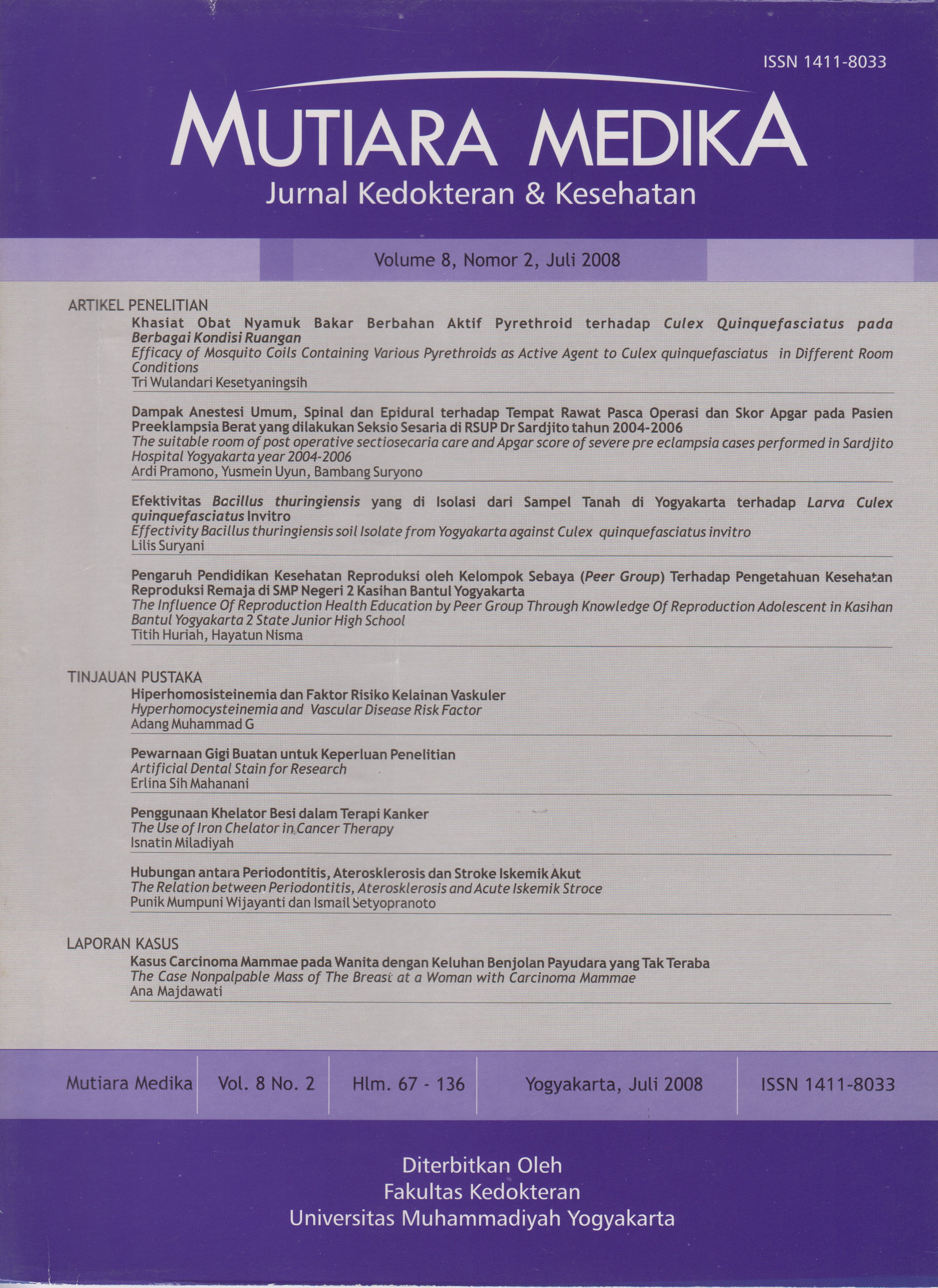Dampak Anestesi Umum, Spinal dan Epidural Terhadap Tempat Rawat Pasca Operasi dan Skor Apgar pada Pasien Preeklampsia Berat yang Dilakukan Seksiosesaria di RSUP Dr Sardjito Tahun 2004-2006
DOI:
https://doi.org/10.18196/mmjkk.v8i2.1476Keywords:
Apgar score, epidural anesthesia, general anesthesia, intensive care unit (ICU), severe preeclampsia, spinal anesthesiaAbstract
The author want to know the place of post operative care and Apgar score of general and regional anesthesia in patients with severe preeclampsia who will be performed sectiosecaria in Sardjito Hospital Yogyakarta year 2004-2006. Data will be collected from medical record. The study will be conducted with cohort retrospective and sample method with consequtive sampling. The inclusion criteria of severe preeclampsia patients were systolic pressure e ” 160mmHg and or diastolic pressure e " llOmmHg before any medical intervention with one or more sign of protein-uria, visual disturbance during pregnancy, and cyanosis, without any disseminated intravascular coagulation (DIC), pulmonary edema, organ dysfunction, and HELLP (hemolytic, elevated liver enzyme, low platelet) syndrome. The recovery room of post operative care was divided into standard room, intensive care unit (ICU) with or without mechanical ventilator. General anesthesia will be limited using tiopenthal as induction agent, and regional anesthesia technique (spinal or epidural) with bupivacain. The result showed that there were no differences in recovery room of post operative care between general, spinal, and regional anesthesia (p>0.05). Apgar score in first 1 minute was significant lower in general compared with spinal and epidural anesthesia.
References
Armanza, E, Karkata, M.K. 2005. Kadar asam urat sebagai prediktor luaran pengelolaan preeklampsia berat preterm. Cermin Dunia Kedokteran No. 146.
GOI & UNICEF. 2000. Laporan Nasional Tindak Lanjut Konferensi Tingkat Tinggi Anak (Draft).
Warden, M. 2007. Preeclampsia (Toxemia of Pregnancy). WebMD, emedicine.com.
Mackay, A., Berg, C.J., Atrash, H.K. Pregnancy-Related Mortality From Preeclampsia and Eclampsia. Obstetrics & Gynecology, 97:533-538
Crosby, E.T. 1991. Obstetrical anaesthesia for patients with the syndrome of haemolysis, elevated liver enzymes and lowplatelets. Can. J. Anaesth. 227-33.
Morgan, G.E., Mikhail, M.S., Murray, M.J. Clinical anesthesiology 3rd ed. Mc.Graw-Hill.
Sibai, B.M. 2005. Diagnosis, prevention, and management of eclampsia, obstetrics & gynecology 105:402-410
Gambling, D.R. 2004. Hypertensive disorders, In: Chesnut, D.H. Obstetric anesthesia principles and practice, 3rd ed. Mosby Inc., USA.
Antoine, G.M.A., Roseline, M., Vialies, N., Ferrer, J., Robert, C., Ripart, J., Coussaye, J.E. 2003. Patients with Severe Preeclampsia Experience Less Hypotension DuringSpinal Anesthesia for Elective Cesarean Delivery than Healthy Parturients: A Prospective Cohort Comparison. Anesth Analg. 97: 867-872.
Stamer, U.M., Wiese, R., Stiiber, F., Wulf, H., Meuse, T. 2005. Change in anaesthetic practice for caesarean section in Germany. Acta Anaesthesiologica Scandinavica, Vol.49.
Wallace, D.H., Leveno, K.J., Cunningham, F.G., Giesecke, A.H., Shearer, V.E., Sidawi, J.E. 1995. Randomized comparison of general and regional anesthesia for cesarean delivery in pregnancies complicated by severe preeclampsia. Obstet Gynecol,86:193-9
Moodley, J. 1990. Treatment of eclampsia. British Journal of Obstetrics and Gynacology: 99-101
Dyer, R.A., Els, L, Farbas, J., Torr, G.J., Schoeman, L.K., James, M.F. 2003. Prospective, Randomized Trial Comparing General with Spinal Anesthesia for CesareanDelivery in Preeclamptic Patients with a Nonreassuring Fetal Heart Trace. Anesthesiology.99:561-9.
James, M.F.M. 1992. The anaesthetist’s role in the management of preeclamptic toxaemia of pregnancy, dalam: Atkinson, R.S., Adams, A.P. Recent advances in anaesthesia and analgesia. Churchill Livingstone.
Umar, H. 2003. Metodologi riset perilaku konsumen jasa. Ghalia Indonesia, Jakarta.
Sastroasmoro, S. 2006. Dasar-dasar metodologi penelitian klinis, edisi ke-2. CV Sagung Seto Jakarta.
Levy, D.M. 2003. Hypertensive disorders of pregnancy. World Federation of Societies of Anaesthesiologists Issue 17:8
Chestnut, D.H. 2004. Obstetric anesthesia principles and practice. 3rd ed., Mosby Inc., USA
Downloads
Published
Issue
Section
License
Copyright
Authors retain copyright and grant Mutiara Medika: Jurnal Kedokteran dan Kesehatan (MMJKK) the right of first publication with the work simultaneously licensed under an Attribution 4.0 International (CC BY 4.0) that allows others to remix, adapt and build upon the work with an acknowledgment of the work's authorship and of the initial publication in Mutiara Medika: Jurnal Kedokteran dan Kesehatan (MMJKK).
Authors are permitted to copy and redistribute the journal's published version of the work (e.g., post it to an institutional repository or publish it in a book), with an acknowledgment of its initial publication in Mutiara Medika: Jurnal Kedokteran dan Kesehatan (MMJKK).
License
Articles published in the Mutiara Medika: Jurnal Kedokteran dan Kesehatan (MMJKK) are licensed under an Attribution 4.0 International (CC BY 4.0) license. You are free to:
- Share — copy and redistribute the material in any medium or format.
- Adapt — remix, transform, and build upon the material for any purpose, even commercially.
This license is acceptable for Free Cultural Works. The licensor cannot revoke these freedoms as long as you follow the license terms. Under the following terms:
Attribution — You must give appropriate credit, provide a link to the license, and indicate if changes were made. You may do so in any reasonable manner, but not in any way that suggests the licensor endorses you or your use.
- No additional restrictions — You may not apply legal terms or technological measures that legally restrict others from doing anything the license permits.






